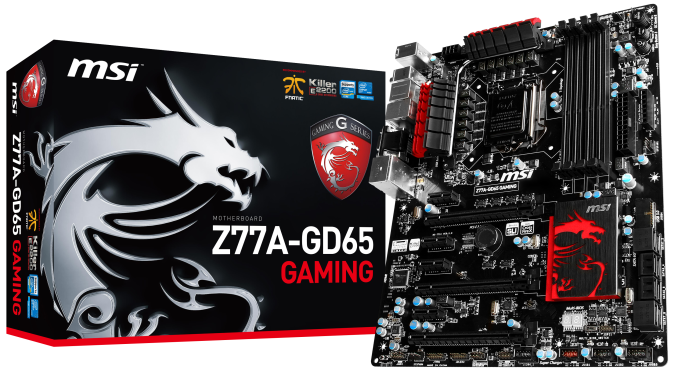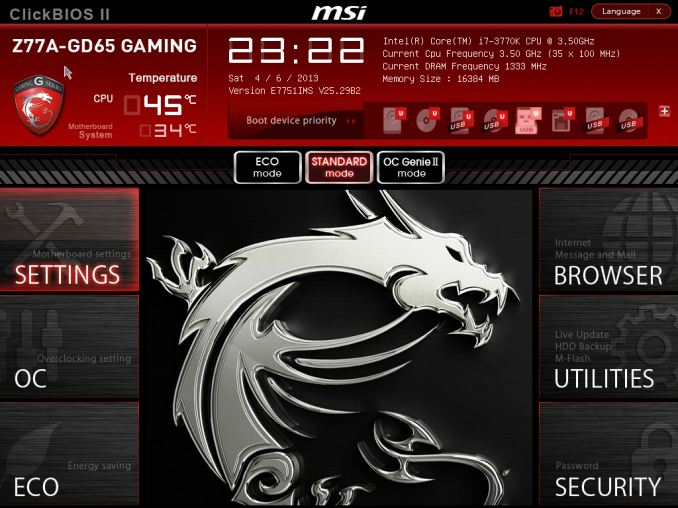MSI Z77A-GD65 Gaming Review
by Ian Cutress on April 18, 2013 12:00 PM EST- Posted in
- Motherboards
- MSI
- Z77
When a product on the market promotes itself as a gaming tool, it cannot just be part of the name or the branding. The product has to showcase why it is a gaming product, and why it is so deserving of our money above and beyond the standard product grade. Associating the product with professional gamers and marketing strongly are worth nothing if the product itself is a poor shell of what is actually good for gamers. Out with the fluff, in with what the real world needs and wants.
It is hard to judge where the MSI Z77A-GD65 Gaming sits on this proverbial spectrum – in almost every way it is the standard Z77A-GD65. What makes it different is the Killer NIC for reduced lag, the gaming port (that has no associated software to make sure it is enabled), and the dragon styling, covering the shape of the VRM heatsink, the chipset heatsink, the BIOS and various elements of the software stack.
The price for all this benefit over the standard model is $15-$30 (when the GD65 is on sale), which is excruciatingly high considering the standard GD65 can be had at common retailers for only $150. For that extra I would want some extra box bonuses, or additional USB 3.0 controllers, or dual NICs, or WiFi, or anything!
Despite all this, the Gaming variant does a better than average job in our benchmark suite. While it seems very power efficient at idle, it starts to approach the higher end when going all out in our gaming suite; performance is better than average, but nothing spectacular especially if a user plans to overclock. The main plus in MSI’s arsenal is Live Update 5, which is great from the ‘keeping up-to-date’ point of view – but all MSI motherboards have this.
The overclocking options, while numerate, are awkward to work with due to any sense of order. I am a big fan of having an easy one button overclock, but the option of an array of one-button overclock modes should the user want to go further. An auto overclock to 4.2 GHz is rather poor given that almost every 3770K sample should hit 4.4 GHz. Why not have two or three options for those that have compatible processors?
Ultimately the Z77A-GD65 Gaming feels a little rushed and out of place, firstly because MSI was planning to release their first gaming boards with Haswell until the Haswell delay, but also because the Z77A-GD65 exists and offers mostly the same functionality for $15-30 less.
Our best ATX board at $180 has been the Gigabyte Z77X-UD5H (bronze award), which features 10 USB 3.0 ports, an mSATA, dual NIC (Intel+Realtek), an included USB 3.0 bracket, and software that offers more auto-overclock options. Is it worth missing on that for dragon styling and a gaming NIC?












37 Comments
View All Comments
IanCutress - Friday, April 19, 2013 - link
The x8/x8 + x4 vs. x8/x4/x4 difference will only showcase for those that need the PCIe slots, and I hope I have pointed this out in every review I have written. The x8 requirement for SLI will definitely feature in my future reviews, and I will be testing it on Haswell for you.After speaking with MSI, they *will* (because I'll hunt them down) be updating their website to make it more obvious to users. A lot of reviews will just go to the back end and copy/paste of the specifications rather than going through them like we try to do, to see where reality meets purpose. In recent months I have found a few glaring errors with both websites and manuals (!).
Ian
Sunstorm - Friday, April 19, 2013 - link
Many thanks Ian. The quality of the reviews here, as well as interactions like this between commentators and the authors are what really make you guys stand out as pretty much the best tech site out there, in my opinion. I'm glad that I have potentially flagged up this SLI issue that has not come up before.WeaselITB - Friday, April 19, 2013 - link
Wow, kudos on this. I'm not really in the market for a new motherboard (and I'm more of a ROG fan, anyway), but this sort of interaction is exactly why I keep reading Anandtech. Awesome.-Weasel
just4U - Thursday, April 18, 2013 - link
Realtek Sound?I noticed the SoundBlaster Cinema Sticker there yet it says Onboard sound is Realtek. Is it software emulation like what you see out of Asus? Or like Gigabyte's Killer series where it really is a SoundBlaster chip?
IanCutress - Friday, April 19, 2013 - link
Software Emulation; the Soundblaster Cinema software package is part of software stack, and enabled it by default. We had to disable it to run our RMAA audio tests properly as it interfered and raised an interchannel leakage error.Ian
just4U - Wednesday, April 24, 2013 - link
Such a shame.. MSI, use the real thing ok? That goes double for you Asus. Doesn't have to be SoundBlaster either but come on these are supposed to be a step above.benbenkr - Friday, April 19, 2013 - link
Why did you guys not test DPC latency on this board?Seriously, DPC latency is like one of the -->MOST<-- important thing to test given how much BS software which comes with all the motherboards these days.
IanCutress - Friday, April 19, 2013 - link
DPC Latency is on page 6, under System Benchmarks (http://anandtech.com/show/6902/6). It's a quick test and there are people who want the info, so we are happy to provide the extra data point. Some boards fail this test spectacularly, so it's good to get onto the manufacturers to fix it.tech6 - Friday, April 19, 2013 - link
Just another cynical marketing attempt to extract more money from the gaming community. Raise the price, make it black, put some cool graphics on it a loud contrasting color and call it a day.Lucian2244 - Saturday, April 20, 2013 - link
Isn't that how every business work?